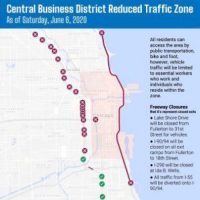Three Cities: Moving Beyond the Barriers
As our Three Cities study shows, Chicago has grown more segregated by income over time. Efforts to change this have been proposed in light COVID-19 and events following the death of George Floyd. We review here the racial and economic divisions that need to be acknowledged and addressed through serious investment of public and private resources.
Racial Breakdown

Racial disparities. While City Three is the most diverse (no racial group composes more than half the population), City One is the most racially homogenous (more than two-thirds of current residents are White). City Two, which is predominantly White, is mixed (1/4 Black and 2/5 Latino).
Income and Health Disparities

Income Disparities. In City Three, where the majority of Chicago’s African American population live, more than half earned less than $35,000 and 1/3 earned less than $20,000 in 2016. In contrast, in City One 45% of the white population earned more than $100,000. In fact, within Chicago overall, nearly 70% of households earning more than $100,000 were white, while more than half of households earning less than $20,000 were African American.
Health Disparities. As our previous blog shows, Covid-19 has reproduced and amplified these disparities. Over the past few months, elected officials and planners (among others) have acknowledged the disproportionate share of coronavirus deaths in predominantly black and brown communities. Due to this disparity, the Department of Planning and Development (DPD) has shifted Invest South/West’s priorities to meet the need for better healthcare facilities on the South and West Sides.
Reducing Disparities

Reducing Disparities. In order for the city’s plan for investment in the South and West sides to have the most impact, these demographic disparities must be considered and prioritized. We must recognize how policy and practice continue to reinforce these divisions. This was evident during the protests and unrest in early June when a “Reduced Traffic Zone” was established, creating a barricade ostensibly protecting City One by blocking access. This kind of decision-making conflicts with the calls for investment outside of the central business district even as the mayor states that there “…is no way we would ever let any neighborhood receive more resources and protection than any others”.
The new Recovery Task Force’s Advisory Report sets the stage for meaningful investment to help eliminate inequities as we work through continued protests for change and COVID-19 recovery in Chicago.